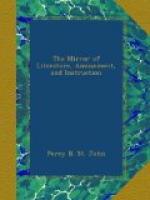[2] Britton’s Architect. Antiq. ii. 86.
[3] Rhodes’s Peak Scenery,
Part iv. p. 4.—One of the oldest
of
these structures at present in the kingdom, is Moreton
Hall
in Cheshire, which, though a highly-ornamented
building,
is entirely composed of wood, and was erected at
a
time before stone was generally used even for the lower
apartments.
The earliest date about this ancient remain is
1559.
[4] Hist. Middle Ages, vol. iii., p. 420.
The “Hall” before us may but ill accord with the present idea of one of these ancient residences; but, to explain away this error, it may be necessary to show in what respects the earliest “halls” (of which but few specimens are extant,) differed from those which remain in considerable numbers, to this day. A passage to this point will be found in Mr. Hallam’s valuable work. “It is,” observes this able historical writer, “an error to suppose that the English gentry were lodged in stately or even in well-sized houses. Generally speaking, their dwellings were almost as inferior to those of their descendants in capacity as they were in convenience. The usual arrangement consisted of an entrance-passage running through the house, with a hall on one side, a parlour beyond, and one or two chambers above, and on the opposite side, a kitchen, pantry, and other offices."[5] Such was the ordinary manor-house of the fifteenth and sixteenth centuries, as appears not only from the documents and engravings, but as to the latter period from the buildings themselves, sometimes, though not very frequently, occupied by families of consideration, more often converted into farm-houses, or distinct tenements. Larger structures




